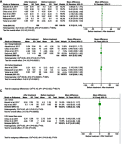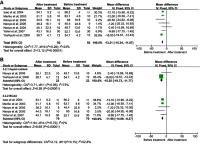Improvement of energy substrate metabolism by late evening snack supplementation in patients with liver cirrhosis: a meta-analysis
- PMID: 31190846
- PMCID: PMC6526777
- DOI: 10.2147/TCRM.S201564
Improvement of energy substrate metabolism by late evening snack supplementation in patients with liver cirrhosis: a meta-analysis
Abstract
Aim: Malnutrition is one of the most common complications in patients with liver cirrhosis. Abnormal energy substrate metabolism may contribute to aggravation of malnutrition. Late evening snack (LESs) supplementation has been recommended as an intervention to reduce starvation time and improve nutritional status. Published studies have analyzed the effect of LESs on the branched-chain amino acid (BCAA)/tyrosine ratio (BTR) and oxidation rate of fat and carbohydrate in patients with liver cirrhosis. Methods: We searched PubMed, Cochrane Library, Web of Science and Embase for relevant research from January 2000 to October 2018. The primary outcome for this analysis was changes in BTR and fat and carbohydrate oxidation in patients with liver cirrhosis. Results: A total of 9 articles, containing 211 patients, were included in this analysis. The results supported that supplementation with BCAA-enriched LESs improved BTR, and long-term supplementation with BCAAs (>1 month) may be more beneficial than short-term supplementation (<1 month) in patients with liver cirrhosis. In addition, supplementation with BCAAs may increase the oxidation rate of carbohydrates and decrease the oxidation rate of fat. Furthermore, compared with liquid-enriched LESs, BCAA was a better choice for increasing the oxidation of carbohydrates and decreasing the rate of fat oxidation. Conclusion: BCAA-enriched LES supplementation is an appropriate nutritional intervention to improve abnormal energy substrate metabolism, which may improve malnutrition in patients with liver cirrhosis. Further research is needed on the long-term benefit and improved survival in patients with liver cirrhosis.
Keywords: branched-chain amino acid; cirrhosis; energy metabolism; late evening snack.
Conflict of interest statement
The authors report no conflicts of interest in this work.
Figures




References
-
- Trovato FM, Catalano D, Musumeci G, et al. 4Ps medicine of the fatty liver: the research model of predictive, preventive, personalized and participatory medicine-recommendations for facing obesity, fatty liver and fibrosis epidemics. Epma J. 2014;5(1):21. doi:10.1186/1878-5085-5-20 - DOI - PMC - PubMed
LinkOut - more resources
Full Text Sources

